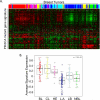Oncogenic PI3K mutations lead to NF-κB-dependent cytokine expression following growth factor deprivation
- PMID: 22552288
- PMCID: PMC3541677
- DOI: 10.1158/0008-5472.CAN-11-4141
Oncogenic PI3K mutations lead to NF-κB-dependent cytokine expression following growth factor deprivation
Abstract
The phosphoinositide 3-kinase (PI3K) pathway is one of the most commonly misregulated signaling pathways in human cancers, but its impact on the tumor microenvironment has not been considered as deeply as its autonomous impact on tumor cells. In this study, we show that NF-κB is activated by the two most common PI3K mutations, PIK3CA E545K and H1047R. We found that markers of NF-κB are most strongly upregulated under conditions of growth factor deprivation. Gene expression analysis conducted on cells deprived of growth factors identified the repertoire of genes altered by oncogenic PI3K mutations following growth factor deprivation. This gene set most closely correlated with gene signatures from claudin-low and basal-like breast tumors, subtypes frequently exhibiting constitutive PI3K/Akt activity. An NF-κB-dependent subset of genes driven by oncogenic PI3K mutations was also identified that encoded primarily secreted proteins, suggesting a paracrine role for this gene set. Interestingly, while NF-κB activated by oncogenes such as Ras and EGF receptor leads to cell-autonomous effects, abrogating NF-κB in PI3K-transformed cells did not decrease proliferation or induce apoptosis. However, conditioned media from PI3K mutant-expressing cells led to increased STAT3 activation in recipient THP-1 monocytes or normal epithelial cells in a NF-κB and interleukin-6-dependent manner. Together, our findings describe a PI3K-driven, NF-κB-dependent transcriptional profile that may play a critical role in promoting a microenvironment amenable to tumor progression. These data also indicate that NF-κB plays diverse roles downstream from different oncogenic signaling pathways.
©2012 AACR.
Figures







Similar articles
-
NF-kappaB/STAT3/PI3K signaling crosstalk in iMyc E mu B lymphoma.Mol Cancer. 2010 Apr 30;9:97. doi: 10.1186/1476-4598-9-97. Mol Cancer. 2010. PMID: 20433747 Free PMC article.
-
Heparin-binding epidermal growth factor-like growth factor inhibits cytokine-induced NF-kappa B activation and nitric oxide production via activation of the phosphatidylinositol 3-kinase pathway.J Immunol. 2005 Aug 1;175(3):1911-8. doi: 10.4049/jimmunol.175.3.1911. J Immunol. 2005. PMID: 16034135
-
Hepatocyte growth factor (HGF) upregulates heparanase expression via the PI3K/Akt/NF-κB signaling pathway for gastric cancer metastasis.Cancer Lett. 2015 May 28;361(1):57-66. doi: 10.1016/j.canlet.2015.02.043. Epub 2015 Feb 26. Cancer Lett. 2015. PMID: 25727320
-
Epithelial growth factor receptor-activated nuclear factor κB signaling and its role in epithelial growth factor receptor-associated tumors.Cancer J. 2013 Nov-Dec;19(6):461-7. doi: 10.1097/PPO.0000000000000001. Cancer J. 2013. PMID: 24270344 Review.
-
Cell plasticity modulation by flavonoids in resistant breast carcinoma targeting the nuclear factor kappa B signaling.Cancer Metastasis Rev. 2024 Mar;43(1):87-113. doi: 10.1007/s10555-023-10134-x. Epub 2023 Oct 4. Cancer Metastasis Rev. 2024. PMID: 37789138 Free PMC article. Review.
Cited by
-
Si Shen Wan Regulates Phospholipase Cγ-1 and PI3K/Akt Signal in Colonic Mucosa from Rats with Colitis.Evid Based Complement Alternat Med. 2015;2015:392405. doi: 10.1155/2015/392405. Epub 2015 Jul 27. Evid Based Complement Alternat Med. 2015. PMID: 26273312 Free PMC article.
-
VHL substrate transcription factor ZHX2 as an oncogenic driver in clear cell renal cell carcinoma.Science. 2018 Jul 20;361(6399):290-295. doi: 10.1126/science.aap8411. Science. 2018. PMID: 30026228 Free PMC article.
-
The emerging role of Wnt5a in the promotion of a pro-inflammatory and immunosuppressive tumor microenvironment.Cancer Metastasis Rev. 2020 Sep;39(3):933-952. doi: 10.1007/s10555-020-09878-7. Cancer Metastasis Rev. 2020. PMID: 32435939 Review.
-
Primary and acquired resistance to EGFR-targeted therapies in colorectal cancer: impact on future treatment strategies.J Mol Med (Berl). 2014 Jul;92(7):709-22. doi: 10.1007/s00109-014-1161-2. Epub 2014 May 10. J Mol Med (Berl). 2014. PMID: 24811491 Free PMC article. Review.
-
Marine Sponge Natural Products with Anticancer Potential: An Updated Review.Mar Drugs. 2017 Oct 13;15(10):310. doi: 10.3390/md15100310. Mar Drugs. 2017. PMID: 29027954 Free PMC article. Review.
References
-
- Cantley LC. The phosphoinositide 3-kinase pathway. Science. 2002;296(5573):1655–7. - PubMed
-
- Luo J, Manning BD, Cantley LC. Targeting the PI3K-Akt pathway in human cancer: rationale and promise. Cancer cell. 2003;4(4):257–62. - PubMed
-
- Engelman JA, Luo J, Cantley LC. The evolution of phosphatidylinositol 3-kinases as regulators of growth and metabolism. Nat Rev Genet. 2006;7(8):606–19. - PubMed
-
- Vivanco I, Sawyers CL. The phosphatidylinositol 3-Kinase AKT pathway in human cancer. Nature reviews Cancer. 2002;2(7):489–501. - PubMed
Publication types
MeSH terms
Substances
Grants and funding
- R37 AI035098/AI/NIAID NIH HHS/United States
- R01 CA075080/CA/NCI NIH HHS/United States
- R01 CA138255/CA/NCI NIH HHS/United States
- R01 CA148761/CA/NCI NIH HHS/United States
- CA75080/CA/NCI NIH HHS/United States
- CA138255/CA/NCI NIH HHS/United States
- R01 CA138937/CA/NCI NIH HHS/United States
- CA148761/CA/NCI NIH HHS/United States
- R01 AI035098/AI/NIAID NIH HHS/United States
- CA73756/CA/NCI NIH HHS/United States
- R01 CA073756/CA/NCI NIH HHS/United States
- AI35098/AI/NIAID NIH HHS/United States
- P50 CA058223/CA/NCI NIH HHS/United States
- P50-CA58223/CA/NCI NIH HHS/United States
LinkOut - more resources
Full Text Sources
Other Literature Sources
Molecular Biology Databases
Miscellaneous

